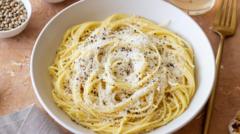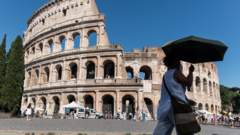A recipe for cacio e pepe published by the UK’s Good Food website has ignited a fierce backlash in Italy, with culinary authorities condemning it for omitting key ingredients and diluting the dish's authentic cultural significance.
Italians Fume Over Misinterpretation of Cacio e Pepe Recipe by UK Website

Italians Fume Over Misinterpretation of Cacio e Pepe Recipe by UK Website
The beloved Roman dish faces misrepresentation as Good Food's recipe sparks outrage among Italians for listing incorrect ingredients and belittling its traditional preparation.
Italians have expressed outrage following the publication of a recipe for the traditional Roman dish cacio e pepe on the UK’s Good Food website, which failed to adhere to the original recipe's principles. The dish, cherished for its simplicity, boasts a reputation for culinary complexity, making Good Food's labeling of it as a "quick lunch" particularly irksome to many Italians.
The controversial recipe lists four ingredients—spaghetti, black pepper, parmesan cheese, and butter—while the authentic version includes only three: spaghetti, black pepper, and exclusively pecorino cheese. The discrepancies led the Italian Federation of Chefs to escalate the issue to the British Embassy in Rome, voicing their astonishment at such a prominent British culinary site misrepresenting a staple of their cuisine.
Claudio Pica, president of the Italian food association, criticized the mischaracterization and emphasized the cultural significance of cacio e pepe, which has roots spanning generations. “This isn’t just food; this is part of who we are,” he asserted, highlighting the deep ties Italians have to their culinary traditions.
Italian media outlets have echoed the frustrations, with dissent being fueled by an overarching sentiment to uphold cultural authenticity in the face of nonsensical recipes. Gastronomy journalist Gabriella Monge lamented, "It’s not just mistaken; it’s an insult!" creating an impactful dialogue within the public sphere.
While adaptations are commonplace, many chefs assert that the essence of a traditional dish should remain untouched. Maurizio, who runs a family-owned hotel in Rome, stressed, "Variations are fine, but you cannot use the original name if you've modified the core ingredients significantly." Fellow restaurateur Giorgio Eramo passionately argued that what was published resembled a completely different dish, suggesting the name “pasta Alfredo” would be more fitting.
The intensity of the backlash underscores a rare emotional response, as Italians feel their culinary heritage is under siege from incorrect representations. Reports reveal a broader context of national pride that extends beyond food—pertaining to how Italy is perceived globally. "Our culinary culture is paramount," said Eleonora, a cafe employee, capturing the essence of Italy's passionate connection to its traditions.
The Good Food website, now under Immediate Media Co., has not yet issued a response amid this rising cultural discontent.




















